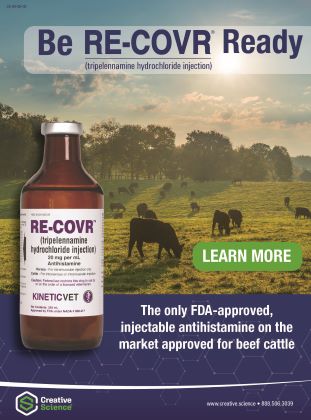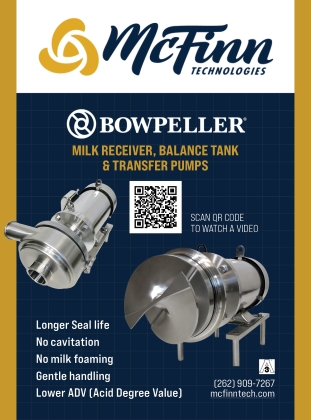Prefeedlot Respiratory Vaccination Improves Cattle Health and Growth Outcomes

A new review in a special issue of Applied Animal Science reveals that strategic timing of bovine respiratory disease vaccinations in beef cattle during the cow-calf phase can significantly improve disease prevention and cattle health
Champaign, IL, July 28, 2025
Bovine respiratory disease (BRD) remains a leading cause of morbidity and mortality in the US beef industry, imposing significant economic and operational burdens on cattle producers, veterinarians, and other industry professionals. Vaccines are a powerful tool for reducing illness and death from BRD. However, even with significant progress in vaccine development, widespread availability, and easy access, the incidence of BRD has remained stubbornly high over the past few decades.
To address this challenge, researchers consolidated what the latest science has to say on current BRD vaccination practices and protocols during the cow-calf production phase. Their new review article, published in Applied Animal Science, identifies potential management practices—in particular vaccine timing—that could improve calf health and performance across the industry. “The authors do a great job summarizing relevant literature and point out potential deficiencies in data and where research should be focused,” said Daniel Rivera, PhD, guest editor in chief of the special issue and associate editor of Applied Animal Science.
The Study
The review’s lead author, Kelsey M. Harvey, PhD, PAS, of the Mississippi State University Prairie Research Unit at Prairie, Mississippi, USA, explained, “The BRD complex is a systemic problem within the US beef industry and is often the result of management practices shifting the burden of control to the next sector of production.” The study found that current vaccination strategies are fragmented across production phases, with insufficient coordination between cow-calf operations and subsequent sectors, limiting the overall effectiveness of BRD prevention efforts.
Harvey and her team analyzed the latest peer-reviewed research literature on the topic, finding that only 57.5% of cow-calf producers (representing 72.8% of the total calves in the United States) vaccinate calves against respiratory disease before or at weaning, despite the cow-calf phase representing the foundation for cattle health in all subsequent production sectors. “By optimizing vaccination timing during the cow-calf phase—when producers have the greatest control over factors that influence long-term cattle health—the industry could significantly reduce both the $25 million spent annually on BRD treatment costs and the $126 million lost to animal deaths, while improving overall cattle performance and well-being and carcass quality throughout the production system.”
The comprehensive review examined vaccination strategies across three critical phases of cattle development: maternal vaccination during pregnancy, early calf vaccination from birth through branding (60–120 days of age), and vaccination timing around weaning (approximately 205 days).
“We analyzed existing studies on both modified-live and killed vaccine formulations against major respiratory pathogens,” said Harvey, “including bovine herpesvirus, bovine viral diarrhea virus, bovine respiratory syncytial virus, and parainfluenza virus, as well as bacterial pathogens like Mannheimia haemolytica.” The analysis specifically focused on how vaccination timing relative to stressful events—such as weaning, transportation, and feedlot entry—affects vaccine efficacy and cattle health outcomes.
Application
The review also highlighted what the literature has to say on innovative approaches, such as intranasal vaccination, to overcome maternal antibody interference and preconditioning programs that separate vaccination from high-stress periods to optimize immune response and reduce disease incidence throughout the production cycle.
While additional research is needed to evaluate cow-calf management interventions on feeder cattle outcomes, this review demonstrates the potential to maximize BRD vaccine effectiveness through strategic timing during early production phases, ultimately improving cattle health and performance throughout the beef supply chain.
The article appears in the August special issue of Applied Animal Science, which showcases previous management and health effects on beef cattle finishing performance.
About Applied Animal Science
Applied Animal Science (AAS) is a gold open access, peer-reviewed scientific journal and the official publication of the American Registry of Professional Animal Scientists (ARPAS). In continuous publication since 1985, AAS is a leading outlet for animal science research and is indexed by Scopus and ESCI (Clarivate’s Emerging Sources Citation Index). The journal welcomes novel manuscripts on applied technology, reviews on the use or application of research-based information on animal agriculture, commentaries on contemporary issues, short communications, and technical notes. Topics that will be considered for publication include (but are not limited to) feed science, farm animal management and production, dairy science, meat science, animal nutrition, reproduction, animal physiology and behavior, disease control and prevention, microbiology, agricultural economics, and environmental issues related to agriculture. Themed special issues also will be considered for publication. www.appliedanimalscience.org
About the American Registry of Professional Animal Scientists (ARPAS)
The American Registry of Professional Animal Scientists (ARPAS) is the organization that provides certification of animal scientists through examination, continuing education, and commitment to a code of ethics. Continual improvement of individual members is catalyzed through publications (including the AAS journal) and by providing information on educational opportunities. ARPAS is affiliated with five professional societies: American Dairy Science Association, American Meat Science Association, American Society of Animal Science, Equine Science Society, and Poultry Science Association. www.arpas.org
About FASS
FASS, the services division of the American Dairy Science Association, provides management services to nonprofit associations and societies with a mutual interest in supporting the advancement of animal agriculture and food systems through research and education. We support nonprofits by providing services for accounting, membership management, convention and meeting planning, information technology, and scientific publishing. The FASS publications department provides journal management, peer-review support, copyediting, composition, and proofreading; the staff includes several BELS-certified (www.bels.org) technical editors and experienced composition staff. www.fass.or
About Elsevier
Elsevier is a global leader in advanced information and decision support. For over a century, we have been helping advance science and healthcare to advance human progress. We support academic and corporate research communities, doctors, nurses, future healthcare professionals and educators across 170 countries in their vital work. Elsevier does this by delivering mission-critical insights and innovative solutions that combine trusted, evidence-based scientific and medical content with cutting-edge AI technologies to help impact makers achieve better outcomes. We champion inclusion and sustainability by embedding these values into our products and culture, working with the communities that we serve. The Elsevier Foundation supports research and health partnerships around the world.
Elsevier is part of RELX, a global provider of information-based analytics and decision tools for professional and business customers. For more information, visit www.elsevier.com and follow us on social media @ElsevierConnect.



